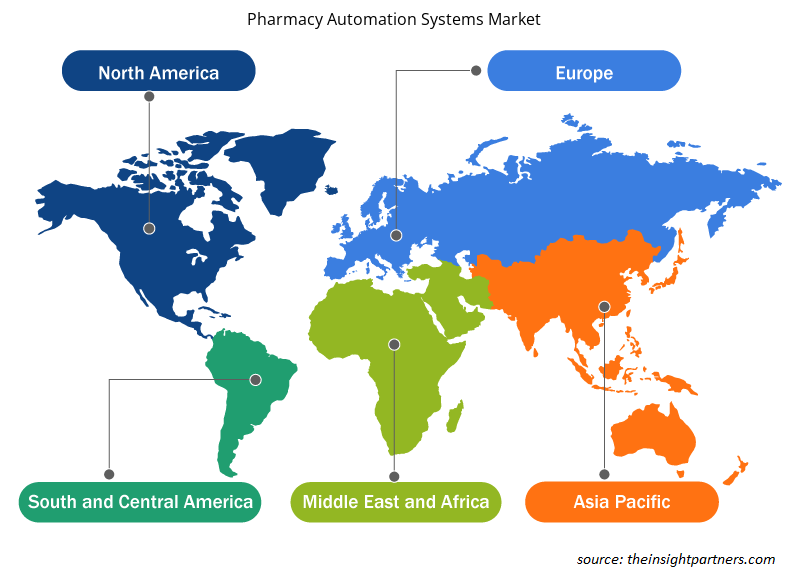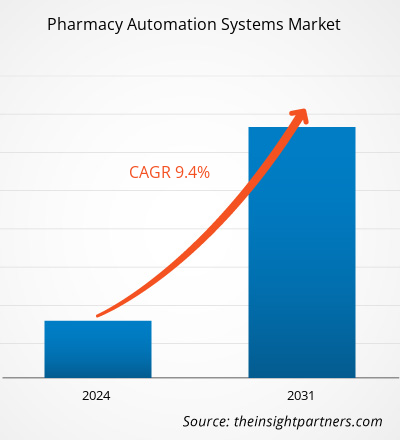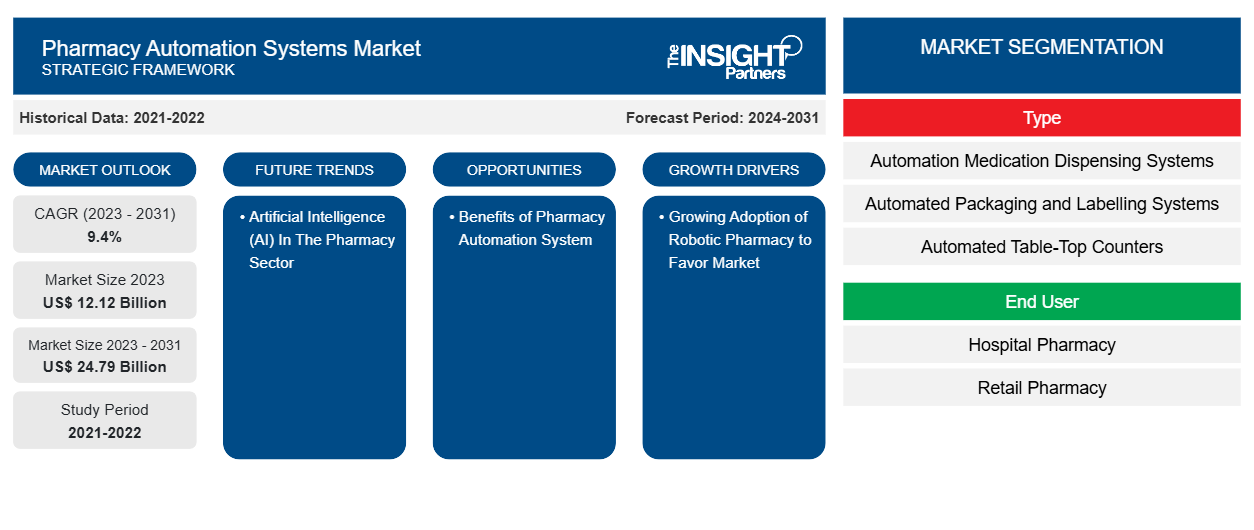药房自动化系统市场规模预计将从 2023 年的 121.2 亿美元增至 2031 年的 247.9 亿美元。预计 2023-2031 年期间市场复合年增长率将达到 9.4%。远程药房的药房自动化很可能仍是市场的主要趋势。
药房自动化系统市场分析
众多市场参与者的存在和不断增加的慢性病发病率是推动市场增长的关键因素。在英国,由于用药错误很多,政府承受着高昂的成本。一年内,报告了近 273 起用药错误,给医疗保健系统造成了 7940 万美元(9800 万英镑)的损失。因此,运营公司与国家医疗服务体系 (NHS) 一起采取战略举措来遏制错误的程度。2023 年 6 月,Omincell UK & Ireland 与荷兰公司 Alphatron Medical 合作,在该国推出了 AMiS-PRO 智能推车。这种情况可能会改变护士的用药工作流程。
药房自动化系统市场概况
药房自动化系统市场驱动因素包括低成本、更少的药物相关错误、更重要的药房工作流程和良好的患者体验。药房自动化系统为药房带来了巨大的好处。此外,老年人患有一种或多种慢性疾病,如糖尿病、关节炎、阿尔茨海默氏症或帕金森氏症;这些疾病的治疗需要定期补充药物。因此,随着老龄化人口的增加,未来几年处方需求将呈指数级增长。目前,自动化集成了自动配药、包装、储存、贴标等,以减少配药错误并提高药房领导者的生产力。
定制此报告以满足您的需求
您可以免费定制任何报告,包括本报告的部分内容、国家级分析、Excel 数据包,以及为初创企业和大学提供优惠和折扣
-
获取此报告的关键市场趋势。这个免费样品将包括数据分析,从市场趋势到估计和预测。
药房自动化系统市场驱动因素和机遇
机器人药房日益普及,市场前景看好
自动化使药剂师从劳动密集型的配送职能中解脱出来,并提高了药房的工作流程效率。此外,随着不断增长的药房网络可以提高患者安全性、降低成本并改善患者体验,机器人技术和自动化系统正在兴起。因此,产品发布也在增加。2023 年 5 月,ScriptPro 获得了《药店新闻》颁发的零售卓越奖——技术和自动化。首屈一指的连锁和零售行业出版物 DSN 聚焦于为客户提供最佳服务的药房技术公司。此外,2022 年 10 月,麦克森公司在俄亥俄州杰斐逊维尔的辛辛那提和哥伦布之间开设了一个新的最先进的医药配送中心。新工厂将向俄亥俄州、印第安纳州、肯塔基州、密歇根州、宾夕法尼亚州和西弗吉尼亚州的客户分销药品、非处方 (OTC) 和家庭保健 (HHC) 产品以及消费包装商品 (CPG)。
制药行业的人工智能(AI)
如今,顶级制药公司已将人工智能技术用于医疗系统分析、药物发现、药物准确性、研发、健康支持和医疗援助、治疗计划设计、协助重复性任务等。人工智能为其他各个行业和领域提供了机会。例如,人工智能还可以通过远程医疗合作、库存管理以及使用聊天机器人模拟患者与药剂师之间的互动来实现。在零售药房和医院药房环境中,人工智能用于跟踪注射药物的准备、条形码扫描等。凭借这些功能,未来几年发展中国家对自动化药房系统的采用也将增长。
药房自动化系统市场报告细分分析
有助于药房自动化系统市场分析的关键部分是类型和最终用户。
- 根据类型,药房自动化系统市场分为自动包装和标签系统、自动药物分配系统、自动存储和检索系统、自动台式柜台和其他类型。自动分配系统类型的药房自动化系统市场分为产品和运营。自动药物分配系统部分在 2023 年占据了更大的市场份额。
- 根据最终用户,药房自动化系统市场分为医院药房、零售药房和其他。医院药房部门在 2023 年占据了更大的市场份额。
药房自动化系统市场份额按地区分析
药房自动化系统市场报告的地理范围主要分为五个区域:北美、亚太、欧洲、中东和非洲、南美和中美。
北美占据了市场主导地位,预计未来几年亚太地区将以最高的复合年增长率增长。亚太市场的增长得益于医疗设备技术中人工智能的不断应用、国际参与者进入该地区的医疗保健市场以及老年人口的不断增加。自动化技术广泛应用于医疗保健行业,推动了对自动化药房系统的需求。中国是西方国家最大的活性药物成分出口国,需要自动化包装和贴标待运输产品。此外,生产基地和仓库在制造基地安装了自动化药房系统。上述因素将推动药房自动化系统市场的发展。
药房自动化系统市场区域洞察
Insight Partners 的分析师已详细解释了预测期内影响药房自动化系统市场的区域趋势和因素。本节还讨论了北美、欧洲、亚太地区、中东和非洲以及南美和中美洲的药房自动化系统市场细分和地理位置。

- 获取药房自动化系统市场的区域特定数据
药房自动化系统市场报告范围
| 报告属性 | 细节 |
|---|---|
| 2023 年的市场规模 | 121.2亿美元 |
| 2031 年市场规模 | 247.9亿美元 |
| 全球复合年增长率(2023 - 2031) | 9.4% |
| 史料 | 2021-2022 |
| 预测期 | 2024-2031 |
| 涵盖的领域 |
按类型
|
| 覆盖地区和国家 |
北美
|
| 市场领导者和主要公司简介 |
|
药房自动化系统市场参与者密度:了解其对业务动态的影响
药房自动化系统市场正在快速增长,这得益于终端用户需求的不断增长,而这些需求又源于消费者偏好的不断变化、技术进步以及对产品优势的认识不断提高等因素。随着需求的增加,企业正在扩大其产品范围,进行创新以满足消费者的需求,并利用新兴趋势,从而进一步推动市场增长。
市场参与者密度是指在特定市场或行业内运营的企业或公司的分布情况。它表明在给定市场空间中,相对于其规模或总市场价值,有多少竞争对手(市场参与者)存在。
在药房自动化系统市场运营的主要公司有:
- 麦克森公司
- 碧迪公司
- Capsa 解决方案有限责任公司
- Omnicell 公司
- 甲骨文公司
- 迪诺瓦公司
免责声明:上面列出的公司没有按照任何特定顺序排列。

- 获取药房自动化系统市场顶级关键参与者概述
药房自动化系统市场新闻和最新发展
药房自动化系统市场通过收集一手和二手研究后的定性和定量数据进行评估,其中包括重要的公司出版物、协会数据和数据库。下面列出了药房自动化系统市场的一些发展情况:
- 韩美科学旗下子公司 JVM 的新一代自动药物分配系统通过高端机械臂“MENITH”成功在欧洲市场上市。(来源:韩美科学,新闻稿,2023 年 10 月)
- Deenova 在维也纳举行的欧洲医院药剂师协会第 26 届大会上宣布推出其屡获殊荣的 D3 机电一体化解决方案产品线的三款创新产品。AIDE-Cut 是 Deenova 最新推出的三款模块化机电一体化解决方案之一,用于对单位剂量的口服固体药物进行重新包装。AIDE-Pack 是 Deenova 为重新包装单位剂量的所有形式的药物(口服和非口服)而开发的新解决方案,而 AIDE-Pick 解决方案则是为了满足亚急性和/或多站点医疗机构集中治疗准备的需求而开发的。(来源:Deenova,新闻稿,2022 年 3 月)
药房自动化系统市场报告覆盖范围和交付成果
“药房自动化系统市场规模和预测(2021-2031)”报告对市场进行了详细分析,涵盖以下领域:
- 药房自动化系统市场规模及全球、区域和国家层面所有关键细分市场的预测
- 药房自动化系统市场趋势,以及驱动因素、限制因素和关键机遇等市场动态
- 详细的 PEST/波特五力分析和 SWOT 分析
- 药房自动化系统市场分析涵盖主要市场趋势、全球和区域框架、主要参与者、法规和最新市场发展3
- 行业格局和竞争分析,涵盖市场集中度、热图分析、知名参与者以及药房自动化系统市场的最新发展
- 详细的公司简介
- 历史分析(2 年)、基准年、预测(7 年)及复合年增长率
- PEST和SWOT分析
- 市场规模、价值/数量 - 全球、区域、国家
- 行业和竞争格局
- Excel 数据集
近期报告
客户评价
购买理由
- 明智的决策
- 了解市场动态
- 竞争分析
- 客户洞察
- 市场预测
- 风险规避
- 战略规划
- 投资论证
- 识别新兴市场
- 优化营销策略
- 提升运营效率
- 顺应监管趋势























 获取免费样品 - 药房自动化系统市场
获取免费样品 - 药房自动化系统市场